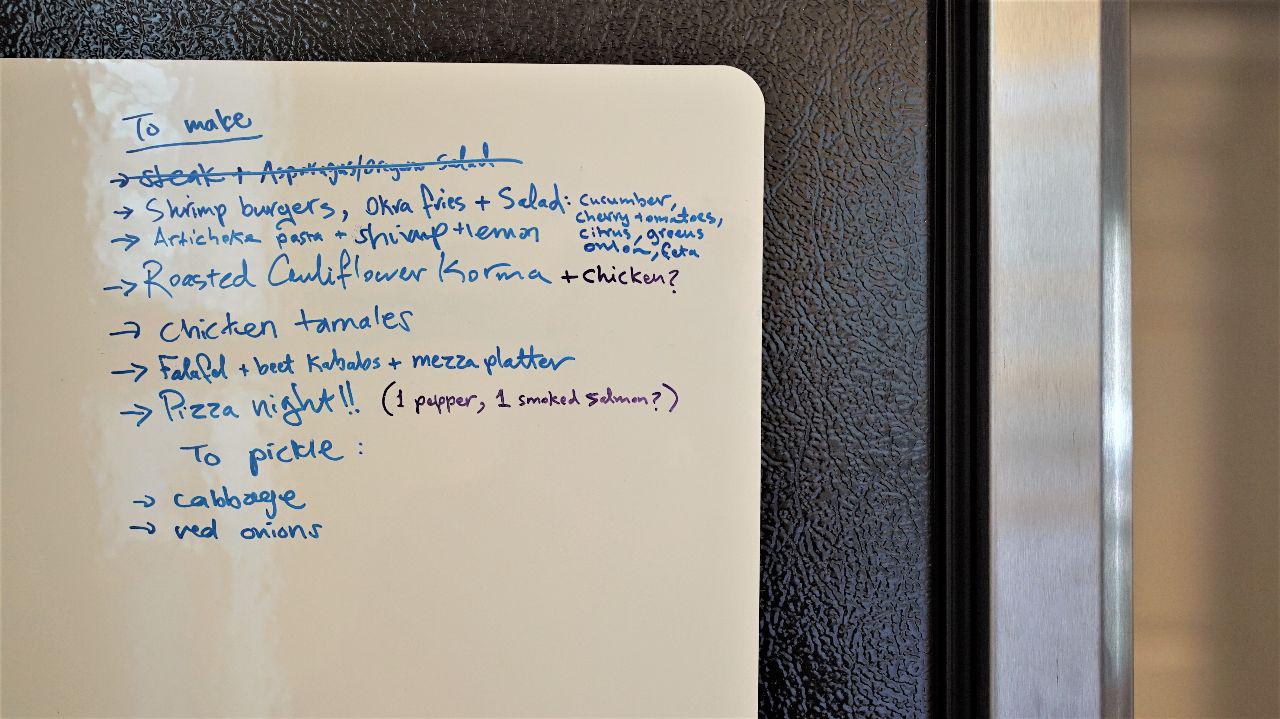
I was planning on getting a tattoo last week. The appointment was set for Tuesday, but the artist and I both thought it would be better to postpone given everything that was going on.
I don't scare easily, nor do I panic (I have after all lived through things like revolution, civilian policing, military curfew, and relentless dictatorship—not to mention being separated from friends and family for a good 6 years now), but I wasn't about to have my skin poked at with needles in the middle of a mass pandemic. This isn't paranoia, it's just rationality; I can live without a tattoo, it's cool.
Managing Expectations
From what I'm seeing, it still seems like there are an awful lot of people who assume we're looking at a 2-week high alert situation before things go back to “normal” (thanks in no small part to misleading addresses from the White House). But I think it's fair to say that it's very clear we're in this for the long haul. The Washington Post noted that “It took three months to reach 100,000 Coronavirus cases worldwide. The second 100,000 took 12 days.”
This thing is sneaky as fuck and really knows how to spread. Out of 285,772 cases so far 11,876 have died. That is a 4.1% death rate (it should be noted though that the rate differs widely per country; 0.97% in South Korea, for example, versus 7.94% in Italy). The estimate right now is that Coronavirus will infect half the global population. What that means is we can expect over 338 million deaths worldwide, at what seems like an unprecedented rate (unless of course strict “social distancing” measures are put in place and kept in practice for the foreseeable future).
There's very little we can do about this unless a vaccine is developed, and it is close to impossible for such a vaccine to be made available before 18 months, if even.
Adapt or Die
What that means is that we are going to have to adapt the way we live to a situation where a deadly very contagious virus is among us. Not for the coming two weeks, but for the coming years. I briefly touched upon the notion of superusers in my recent newsletter, in that there are superusers for everything. Our species may not have dealt with anything like this, not since the Black Death (a combination of both bubonic and pneumonic plagues) and the Spanish Flu, but among us walks a very specific segment of society comprised of superusers of life-with-substantial-threat-of-viral-infection, and it is from them we may need to learn a thing or two. Mark Schoofs for Buzzfeed: How to Survive Yet Another Plague – I Lived Through The Aids Epidemic. Here's How To Live Through Coronavirus. Very poignant, very important read.
One of the biggest takeaways from Mark's essay is the realization that this isn't something you can just wait out, nor is it something you can rely on the government to solve for you. This is something that we, the potential carriers (which in this particular case is every single human being on the planet, regardless of habits or lifestyle) will have to adapt to. Essentially, we all need to wear condoms on our hands and faces now.
We also need to constantly disinfect surfaces, wash hands regularly, limit physical interaction with one another as much as possible. This, many of us already know, because it's all we've been getting from various media for the past couple of weeks, isn't it?
Yet, I've seen an awful lot of people not entirely complying. And I'm not talking about the deniers and disbelievers, I'm talking about the ones who think it's enough to wipe their shopping cart handles at the supermarket, while continuing to share breathing space without need for gloves or face-masks (also, postal workers—at least here in Houston—were not provided with either). I should note that I'm anything but a germaphobe. I've eaten off of street carts in Cairo and Hanoi, am used to greeting friends with hugs and kisses, have never shied away from liberally sharing drinking straws, and have never purchased a bottle of hand-sanitizer not once in my life. However, A VERY DEADLY AND VERY CONTAGIOUS VIRUS LIVES AMONG US NOW! Out of love and compassion for other human lives, taking necessary precautions shouldn't even be optional. It's a necessity. It's clear that not enough people fully understand how Coronavirus works. And even many who do seem to think that properly dealing with it only requires temporary measures.
While I understand the need for people to believe that for the benefit of one's own comfort and sanity, but that's only if you're frightened by the notion of adaptability, of needing to make lifestyle changes in order to adapt to a new reality. We, as a species, do it all the time though! We've even done it within our own lifetime(s) (it should be as clear as day to anyone above thirty). That is a reassuring thought, isn't it? We're good at adapting. We can do this. The difference this time is that the changes we make are going to have to be relatively drastic and enacted at unprecedented speed.
Luckily, it's almost as if we've been working towards this moment for a very long time now; we have the technology to move many of our interactions to the virtual realm, we can have almost anything we need delivered to our doorsteps, and much of our cultural entertainment is already streamable.
The New Normal of the Future
If a vaccine cannot be developed in less than 18 months, then we must envision how life under Coronavirus can be sustained for at least 18 months (if not more). We then must also envision the ripple effects those 18 months will have on the culture at large beyond those 18 months, likely for the entire decade that is the 2020s.
The New Workplace
Home will be the new workplace for most people. A trajectory we were heading towards anyway. Co-working spaces? Definitely done for. Certain jobs that are simply impossible to get done remotely will require specific protective gear, utilizing knowhow gained from industries that deal in hazardous matter.
The New Public Gathering
Maintaining a two-meter distance will likely become the new norm, but only in open spaces. You can forget about public gatherings in closed spaces, which will make theaters, restaurants and cafes as we know them completely obsolete. We'll instead see a proliferation of takeout-based establishments, and maybe even a return of the German-style Automat (which has already made a soft comeback in San Francisco anyway). Establishments designed to accommodate sit-in patrons will have to be entirely rethought with necessary social distancing and sanitation in mind; a very low cap on the number of patrons within, fewer tables, and perhaps a proliferation of booth-style seating. Bartenders, baristas, and cooks will all be required to wear the necessary protective gear.
The New Workforce
Protective gear will be required by all on-site jobs that need to be performed by humans. Anything that needn't be performed by human beings simply will not. We've already witnessed the birth of the RoboVac, the occasional Robot Bartender, and smart warehouses. We can expect an acceleration in the development of robotics and a severe reduction in jobs performed by humans. These will be welcomed by the general public because it will no longer be a matter of maximizing corporate profit and instead be a matter of preserving human life.
The New Travel
We've experienced a good century of unprecedented human travel. This will probably slow down and travel will only be on a need-be basis for most people (which wouldn't be so bad for the environment). On the short run, airlines may start giving passengers mandatory gloves and face-masks. If however it is proven that that is not enough to keep Coronavirus from spreading between people in tight closed spaces, airplanes will likely be retrofitted with private cabins. This of course will make air-travel very expensive and reserved solely for the elite. Given that boats can accommodate more private quarters (not to mention actual fresh air), we may see a serge in sea travel for non-business related purposes. With most people working remotely anyway, this really shouldn't interfere with employees' limited time off. If you can do the job from home, you can arguably do it on a wi-fi equipped cruise ship.
The New Socioculture
Cultural habits can differ from one place to another, but sometimes a trait from one culture can spill over and take root in another. Casual handshakes, hugs, and kisses will be no more. Enter the Japanese bow. It may first start with a nod, but time may prove the nod too casual a gesture in front of a senior or someone worthy of a bit more respect.
Also, promiscuity? Too risky. We've lived a good era of relative free-love, bar pickups, sex clubs, and random Tinder hookups—but we can expect sexual relations to take a turn to the very conservative. This has all happened before; some people forget that before the “Swinging Sixties”, there were the “Roaring Twenties”. The three decades in-between? Quite conservative. The Eighties also saw a return to conservatism. Such sexually conservative cycles almost always coincide with the spread of infectious disease.
The New Art & Culture
Aside from the importance of healthcare funding, Coronavirus has also reaffirmed the importance of culture. With the majority of us forced to stay home, we're quickly realizing the importance of film, television, music, and books as psychologically necessary comforts. This decade should see an uptick in affordable and easily accessible cultural output. Much of it may be virtual/streamable (even museum exhibitions), but too much of the untouchable may see a renewed appreciation for tactile things; subscription-based publications and other printed matter that utilize textured papers and a mixture of printing techniques may be on the upswing.
The New Tech
Given that the touching of surfaces is proving to be potentially lethal, all new tech in the coming decade will be optimized for contactless usability. Voice commands and hand gestures (powered by bluetooth rings) will dominate devices and appliances.
The New Fashion
Masks will become as mainstream as pants. Air-filtering scarves will become a thing, and we may even see shirts designed with mouth covering parts that you can just pull up when necessary (think of it as an evolved turtleneck). Gloves will definitely make a fashionable comeback. Tattooing will be seen as an easy harbor of disease and quickly lose the mainstream acceptance it has gained over the past three decades.
The New Food Supply
All viruses come from animals. Some viruses that cause the flu come from birds and pigs. HIV AIDS from chimpanzees. COVID-19? Evidence suggests it may have went from a bat to pangolin before making the jump to a human. It is that jump that results in the kind of hybrid-viruses that are particularly destructive to human immune systems (The 1918 Spanish Flu is thought to be a mix of avian and swine flus).
Thing is though that bats and pangolins don't traditionally mix in nature. It is human interference that brought both species together in a marketplace in Wuhan, China, where a large variety of live animals are kept in tight cages within close proximity to one another; the very same conditions that led to the SARS outbreak of 2003, where a Civet Cat is thought to be the culprit (or one of a combination of culprits).
(It should be noted though that if you caught SARS, symptoms would show very quickly. COVID-19 symptoms may not reveal themselves for a full 15 days [if at all], during which the carrier could very easily and unknowingly infect others. It's basically a more clever SARS.)
Essentially, nature has sent us the warning signs time and time again, but we seem insistent on carrying on “business as usual”. Westerners inclined to jump on racist bandwagons without ever questioning their own capitalist practices may put the blame entirely on another culture, but really animal cruelty is at the heart of these viral outbreaks be it Eastern or Western. It is not enough to ban wet markets in China, nor is it enough to ban wildlife trade. No animal should ever be caged, nor should their habitats be destroyed, nor should they ever be forced to mix with other species they wouldn't naturally mix with. All of that should be strictly criminalized.
We will likely see a rise in veganism, and those who cannot give up their carnivorous ways may be inclined to say goodbye to supermarkets and mass-produced meats and instead source their foods from small local farms they know and trust.
In order to adapt, big brands may start shutting down their industrial facilities and outsourcing their production to small farms instead.
Or, they may instead transform their big industrial facilities into megalabs where meat is grown instead of raised. These will be touted as more hygienic, environmentally-safe, and cruelty-free.
The New Urbanism
The rising public-transit movement will die, and preference for the private automobile will be the only thing that makes sense. Suburbs and gated developments will make a comeback as idealic living bubbles, and cities and downtowns will lose both funding and investment, relegating them as dirty, dangerous, and derelict. A new wave of “white flight” will result in a kind of reverse-gentrification, making city centers affordable to struggling classes again. The discernible diversity of city centers combined with the lethal threat cities harbor as viral cesspools will rekindle false notions in the minds of Whites regarding race and disease; and in turn an acute revival of white supremacy in the mainstream.
The New Globalism
One person's actions on one side of the planet can effect everything and everyone on the rest of the planet. From public health to politics to entire economies. The outbreak of COVID-19 has been made this more clear than ever. As such a new kind of Globalism will take root wherein the world must function as a global village, with laws, regulations, and the systems by which our lives operate being designed with the entire globe in mind. Paradoxically, human interaction is now potentially lethal, so households and human relations more generally will be forced to become increasingly atomized and super-local.
The New Cultural Divide
During the Plague, Europeans blamed the “miasma” carried forth by winds coming in from the East and South (Ottoman lands basically). When an 18th century American missionary stationed in Egypt witnessed Cairo's 1781 plague, he concluded that it was brought in by a Jewish merchant and two black female slaves. The spread of disease on a wide scale has always brought about the racist leanings already harbored by human beings. With the outbreak of Coronavirus and one marketplace in China being pointed to as the source, we can expect the emergence (or reemergence rather) of a great cultural divide between the greater East and overall West. Everything “Eastern” (because racism isn't logical) will be seen by a greater number of Westerners as wholly inferior, the once growing interest in Eastern cuisine, books, and cinema will come to a sudden halt (while paradoxically picking up other traits out of necessity; the Japanese bow, bamboo-made disposables, and an obsession with robots for example).
The New Frontier
More interest and funding will be put towards finding and developing a new human habitat away from Earth, be it on Mars or elsewhere; a “Plan(et) B” where the human race (or a particular segment of the human race rather) may live and prosper far from the hundreds of thousands of viruses on Earth threatening to kill us at any moment.
Some say human evolution is cyclical rather than linear. After all, the glory of the Roman empire was followed by the European dark ages. By the time Europeans made it to the Americas, entire Mayan cities had already been abandoned for centuries.
I wonder if human evolution is a combination of both cyclical and linear trajectories though. Given that our very planet revolves around its own access, as well as around the sun which itself moves in an eclipse within the milky way, which itself speeds through the universe... why should human existence be any different?

#Journal #Covid19 #Future

















